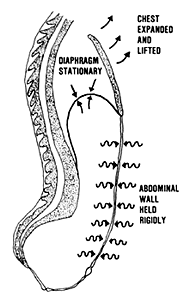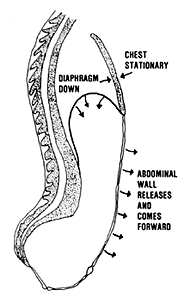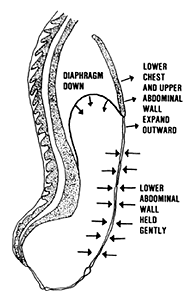| |
|
Three basic ways of breathing are illustrated and described in "For Clarity of Mind" by David Coulter. Chest breathing evokes tension while diaphragmatic breath promotes attention. Added emphasis appears in red, and my reactions are enclosed in a box: (Note 61)
 |
Chest Breathing
- On inhalation the diaphragm is almost immobile.
- The abdominal wall is held rigidly.
- The intercostal muscles actively lift the chest up and out.
- The rib cage expands.
- The mental state is anxious.
|
| With a diaphragm flabby from disuse, chest breathing became the norm. Weight training restored the diaphragm to health. |
|
Abdominal Breathing
- On inhalation the dome of the diaphragm moves down in a fairly simple piston-like action.
- The abdominal wall is relaxed and pushed forward by the diaphragm during inhalation.
- The intercostal muscles actively hold the chest wall in a stable position.
- The rib cage does not expand.
- The mental state is relaxed.
|
 |
| When I go to bed, I consciously shift to abdominal breathing to help me go to sleep. I avoid breathing this way when using the relaxation posture to keep from going to sleep. |
 |
Diaphragmatic Breathing
- On inhalation the dome of the diaphragm presses down against the abdominal organs.
- The abdominal wall is relatively taut.
- The intercostal muscles maintain the shape and integrity of the chest wall.
- The rib cage is flared at its base by the attachment of the diaphragm.
- The mental state is clear and attentive.
|
| As often as I remember sitting at the keyboard, I check to see that I'm at least breathing abdominally. With concentration I return myself to diaphragmatic breathing. |
|
|
|
BACK |


